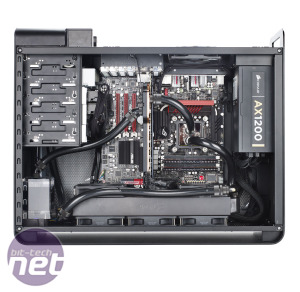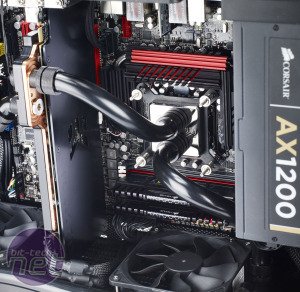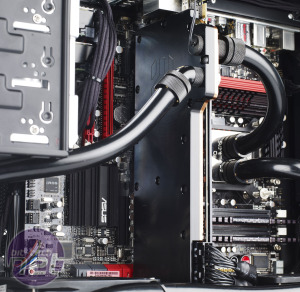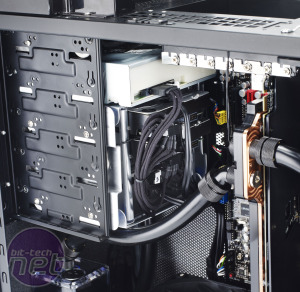
Scan 3XS Scorpion X PC Review - Core Hardware
Behind the watercooling loop’s tubing system is some of the very best hardware currently available. The base for the build is an Asus Maximum IV Extreme Rev 3 motherboard – so new that we received our sample from Asus a few days after the Scorpion-X arrived. This ROG board has every cutting edge feature you can imagine, from two Gigabit Ethernet ports to six USB 3 ports on the rear I/O block and remote overclocking via ROG Connect.The board also offers more overclocking options than we could shake an arachnid at, which is appropriate considering the 3.4GHz Intel Core i7-2600K CPU has been overclocked to 4.8GHz. This is more than a 40 per cent increase in clock speed, and matches the best overclocks we’ve managed with the same CPU. This excellent overclock is achieved with a Base Clock of 100MHz, a multiplier of 48x and a vcore of 1.425V. However, this vcore is somewhat higher than the 1.35V we’ve typically found you need to push a Core i7-2600K to 4.8GHz. Alongside the CPU sits 8GB of Corsair Vengeance DDR3 1,600MHz memory – aside from the capacity, this is a fairly mundane choice for such a high-end system.
Rounding off the list of awesome hardware is an Nvidia GeForce GTX 590 3GB GPU. Fitted with two full-fat GF110 GPUs, each with access to 1.5GB of GDDR5 memory, it’s a monster of a graphics card.
As standard, the GTX 590 3GB runs with a GPU core frequency of 607MHz and a stream processor clock of 1,214MHz, while the memory operates at 853MHz (3.4GHz effective). However, Scan has overclocked the card so that it has a GPU core clock of 650MHz and a stream processor frequency of 1,300MHz. While this overclock is only a 7 per cent increase, it’s all the card is capable of accommodating while remaining completely stable at its stock core voltage.
Somewhat disappointingly, considering the Scorpion’s price tag, Scan has chosen not to include a sound card with the Scorpion-X. This leaves it with just the motherboard’s onboard Realtek ALC889 audio codec, which wouldn’t be our first choice of sound device. Considering the excellent Asus Xonar DX can be had for around £55, its omission is a little stingy.
For storage, Scan has fitted the Scorpion with a great combination of both an SSD and a couple of hard disks. The operating system is installed on an Intel Elmcrest SSD, which uses the same Marvell drive controller as found in the Crucial C300 and provides sequential read speeds of up to 450MB/sec. For bulk storage, there are two Western Digital 1TB Caviar Black hard disks in a mirrored RAID 1 configuration, which should lead to less chance of data loss.
Also housed within the Scorpion-X’s drive bays is an Aquaero control system, with its VF display fitted in a 5.25in drive bay. The Aquaero can monitor and adjust any of the case’s fan voltages (they’re set to 12V by default), as well as report from one of four temperature sensors dotted throughout the case; there’s even a temperature sensor fitted into the water-cooling loop to report the coolant temperature. It’s a neat addition and while not the most intuitive piece of equipment to use, it's well fitted and very configurable.
Rounding off the build is a Corsair AX1200 PSU, complete with some nifty individually braided SATA and Molex power cables. All in all, the Scorpion-X is seriously impressive build, combining some of the very best hardware we’ve seen in the last few months.

MSI MPG Velox 100R Chassis Review
October 14 2021 | 15:04












Want to comment? Please log in.